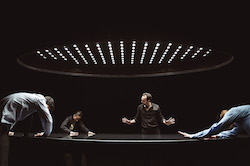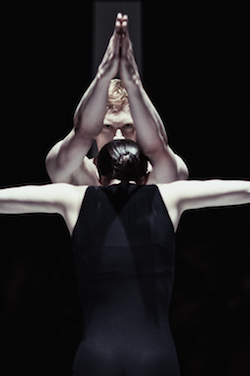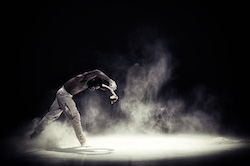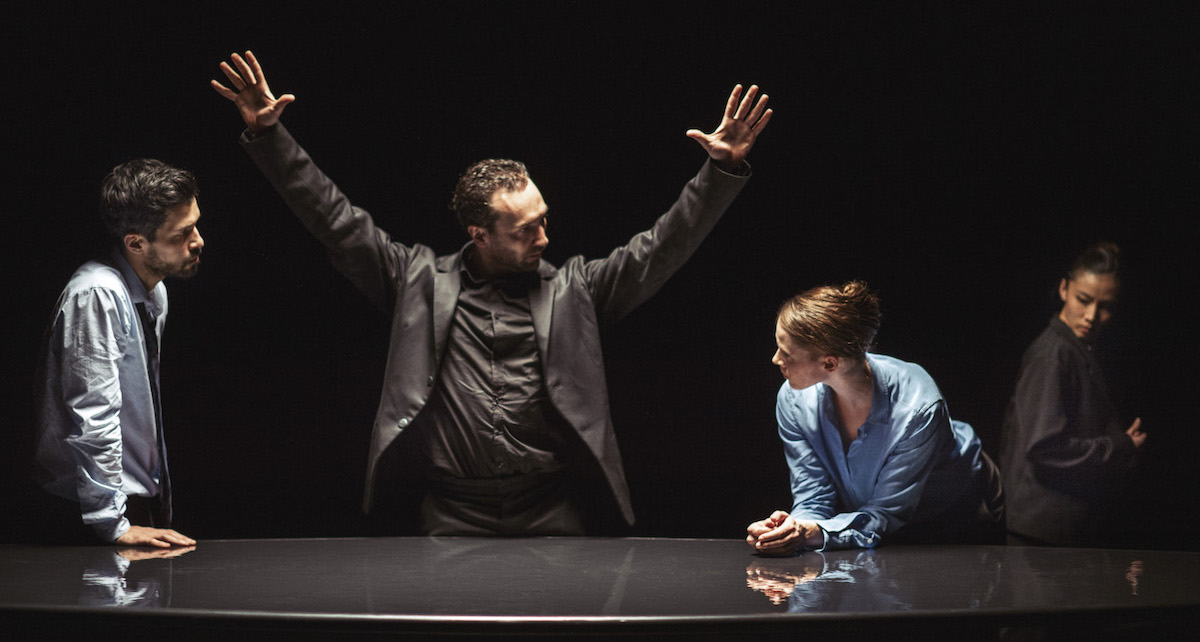NY City Center, New York, NY.
November 18, 2016.
A performance by Nederlands Dans Theater (NDT) is always highly anticipated in NYC. The contemporary company, directed by Paul Lightfoot, is home to some of the world’s best dancers, who are all extremely technically proficient, with a sense of classical line combined with extreme physicality. And the company has a collection of some of the most thought-provoking repertory by innovative choreographers. Together, this always makes for a performance that tugs at audience’s heartstrings and has the power to implant its images in the viewers’ mind for days following.

NDT in Crystal Pite’s ‘The Statement’. Photo by Rahi Rezvani.
Such was the case at NDT’s run at NY City Center, where the company brought four works: two new this year (Marco Goecke’s Woke Up Blind and Crystal Pite’s The Statement) and two by husband-and-wife choreographers Lightfoot and Sol León (2001’s Safe as Houses and 2014’s Stop-Motion).
In particular, Pite’s riveting work was literally the talk of the town over the course of NDT’s engagement, and for good reason. In The Statement, dancers are dressed in business wear and surrounded by a conference table with a large overhead light fixture. It is a dance-play – a recorded reading of playwright Jonathon Young’s text is brought to life by the dancers’ movements. What starts out as humorous – dramatic head motions and hangs from the table in reaction to the voiceovers – soon turns dark and tense. A “situation” in an office had escalated, and we fear for one’s demise. Even the lighting by Tom Visser helps convey and alter the scene’s mood.
Incredibly unique in concept and mesmerizingly performed by the NDT dancers – Chloé Albaret, Aram Hasler, César Faria Fernandes and Roger Van der Poel – The Statement is a work that makes us feel something, as we ache for more of it.

NDT in Paul Lightfoot and Sol León’s ‘Safe as Houses’. Photo by Rahi Rezvani.
León and Lightfoot’s Safe as Houses brings us to another world – one divided by color and soaked in chance. A pivoting wall, which rotates like the hands of a clock, split clusters of dancers dressed in either black or white. Entrances and exits become invisible and mysterious, and the dancers often come so close to the wall’s moving edges but keep their cool. León and Lightfoot’s choreography shows off the dancers’ extreme flexibility and calm inner strength, and the partnering sequences are particularly seamless and effortless. We are also shown how beautifully different the NDT dancers look, and the universal feeling of the group aides in making it all feel even more real.
Goecke’s Woke Up Blind uses some lesser-known songs of Jeff Buckley, and his emotive voice and aggressive guitar work is emulated in the dancers’ gestures and movement. As Buckley’s haunting voice fills the theater, the dim stage with a single hole of light piercing through the back scrim falls upon the dancers, who shift maniacally through the space, as if they’re haunted and troubled, too. The emotive resonance of the work is escalated when two dancers appear as lovers in distress. When watching Woke Up Blind, we feel almost crazy and neurotic ourselves and, at moments, alone.
León and Lightfoot’s Stop-Motion is a long work but one full of images and meaningful shapes created by the dancers’ bodies. The work is dedicated to the choreographers’ daughter, Saura, who, adorned in period clothing, is projected on a large screen downstage and moves slowly in black and white.

NDT in Paul Lightfoot and Sol León’s ‘Stop-Motion’. Photo by Rahi Rezvani.
Even as the dancers again show off their endless extensions, other moments – a dancer shuffles slowly back and forth, scooping and lining up small piles of white dust, for example – are subtle but just as captivating. A particularly beautiful solo for Prince Credell, who moves and slides through a large pile of white powder (the first time we see the prop) to the emotional strings of Max Richter’s score, leaves us wanting more.
NDT always leaves us wanting more. The dancers are some of the cleanest and strongest in the world, and the company’s repertory always proves to be a gratifying source of dance theater at its finest.
By Laura Di Orio of Dance Informa.















